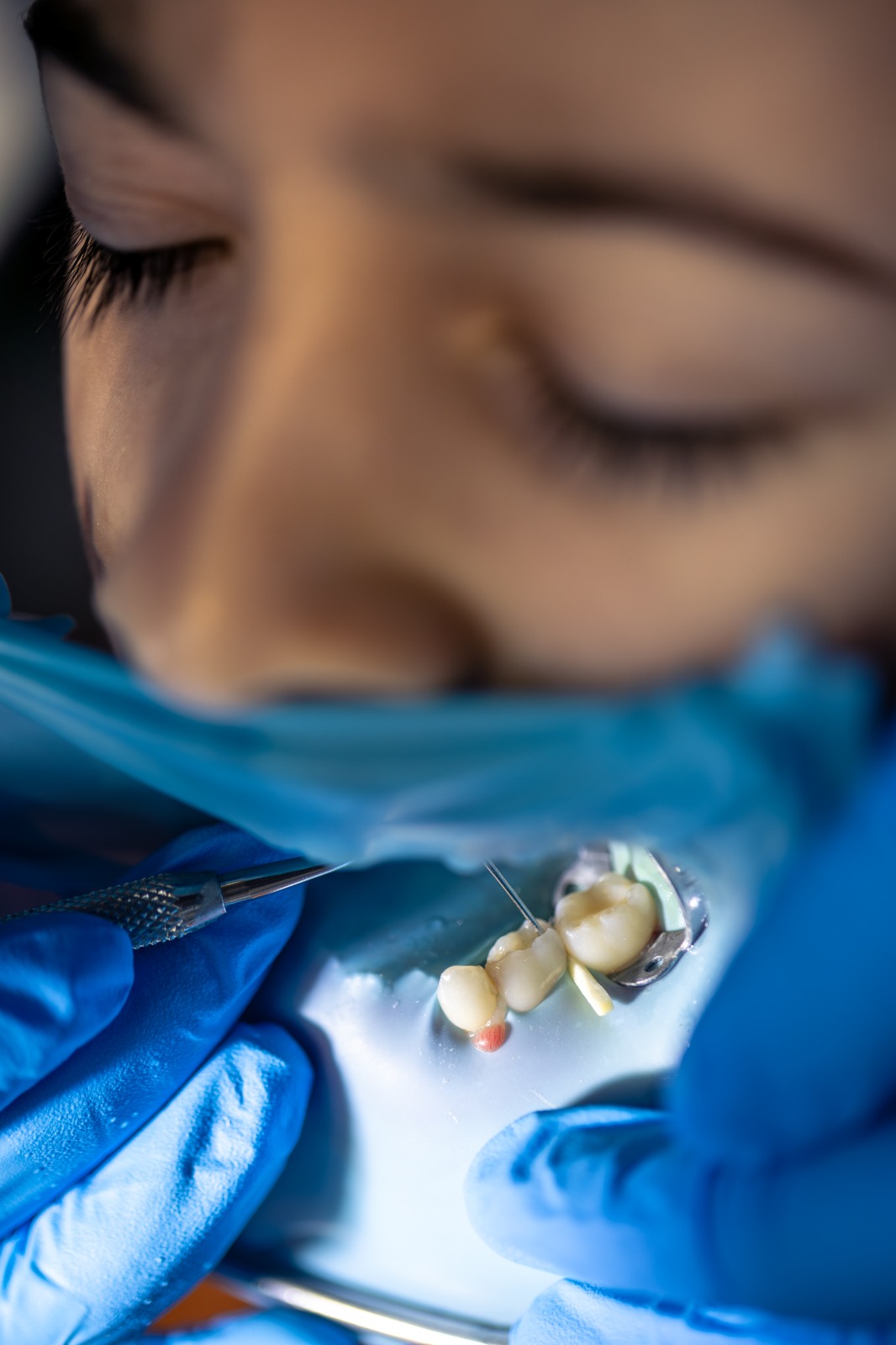What's the Apicoectomy Procedure?
Facing persistent tooth infection? We’ll explore the apicoectomy procedure, its steps, recovery, and success rates to save your natural tooth.

When your dentist mentions an apicoectomy, it might sound intimidating. But this minor surgical procedure could be the key to saving a tooth that would otherwise need extraction. An apicoectomy, also known as root-end surgery, targets persistent infections at the tip of your tooth's root when conventional root canal treatment hasn't resolved the issue.
Unlike a standard root canal, which cleans the tooth from the top down through the crown, an apicoectomy works in the opposite direction. Your dentist makes a small incision in your gum, removes the infected root tip, and seals the end to prevent future problems. It's essentially giving your tooth one last chance before considering extraction.
What is an apicoectomy?
An apicoectomy is a targeted surgical procedure that removes the apex (tip) of a tooth's root along with any surrounding infected or inflamed tissue. Think of it as a precise cleanup operation at the very end of your tooth's root, where bacteria sometimes hide despite previous root canal treatment.
The procedure is a minor surgery, not a major hospital operation. You'll be in and out the same day, usually within an hour. The goal is simple: preserve your natural tooth when conventional retreatment isn't possible or hasn't worked.
Most importantly, an apicoectomy lets you keep your natural tooth. Your bite stays normal, you avoid the need for implants or bridges, and you maintain the bone structure around that tooth.
When is it needed?
Several situations might lead your dentist to recommend an apicoectomy instead of retreating your root canal or extracting the tooth entirely.
- Persistent infection after root canal treatment is the most common reason. Sometimes bacteria remain in tiny spaces that instruments can't reach, or infection develops outside the root canal system. You might notice ongoing pain, swelling, a bad taste, or see a small bump (abscess) on your gum.
- Blocked canals present another challenge. If calcium deposits have formed or if posts and crowns make it impossible to access the canal from the top, an apicoectomy provides an alternative route to clean and seal the infection.
- Complex root anatomy can hide extra canals or unusual shapes that weren't addressed in the original treatment. Some teeth have accessory canals or root fractures that only become apparent during surgical exploration.
- Cysts and granulomas sometimes develop around infected root tips. These are your body's way of walling off infection, but they won't heal without removing the source of irritation.
However, apicoectomy isn't suitable for every situation. If your tooth has a vertical root fracture extending up into the crown, severe gum disease, or isn't restorable due to extensive decay, extraction might be the better option.
Procedure step by step
Understanding what happens during an apicoectomy can help reduce anxiety about the procedure. Here's the typical sequence:
Preparation and anesthesia
Your dentist will review recent X-rays or cone-beam CT scans to map out the area around your tooth. Local anesthesia (similar to what you'd get for a filling) completely numbs the area. Some patients opt for additional sedation if they're anxious, but it's rarely necessary.
Creating access
A small incision in your gum tissue exposes the bone covering your root tip. This isn't as dramatic as it sounds. The incision is usually only about 10-15mm long. Your endodontist gently lifts the gum tissue to create a small flap.
Bone removal and root access
Using specialized instruments, your endodontist removes a small amount of bone to expose the infected area around your root tip. Modern tools make this step more precise and comfortable than traditional methods.
Cleaning and root tip removal
All infected tissue around the root gets carefully removed. Then your dentist cuts away about 2-3 millimeters from the tip of the root. This eliminates any bacteria hiding in the root's tiny branches and creates a clean surface for sealing.
Root-end preparation and sealing
The exposed root end is prepared with ultrasonic instruments and sealed with biocompatible material.
Closure
Your endodontist repositions the gum tissue and places sutures. Most practices use dissolvable stitches that disappear on their own within 7-10 days, though some prefer removable sutures that come out after about a week.
The entire procedure typically takes 30-60 minutes for a single root, though complex cases involving multiple roots may take longer.

Recovery & aftercare
Recovery from an apicoectomy is usually straightforward, but following aftercare instructions helps ensure optimal healing.
First 24-48 hours
Expect some swelling and tenderness - this peaks around day two and then gradually improves. Apply cold packs for 20 minutes on and 20 minutes off during the first day to minimize swelling. Take prescribed or over-the-counter pain medication as directed.
Stick to soft foods and avoid chewing on the surgical side. Cold or room-temperature foods feel more comfortable than hot items. Avoid using straws, as the suction can disturb the healing area.
First week
Gentle oral hygiene becomes essential after the first day. Brush your teeth normally, but avoid the surgical site. Rinse gently with warm salt water (1/2 teaspoon salt in a cup of warm water) after meals to keep the area clean.
Avoid smoking altogether; it significantly slows healing and increases infection risk. Alcohol should also be avoided, especially if you're taking pain medication.
Ongoing healing
Gum tissue heals within 1-2 weeks, but bone regeneration continues for several months. You'll have follow-up appointments to monitor healing, typically at 1 week, 3 months, and 6 months. X-rays track bone regrowth around your root tip.
Most people return to normal activities within a day or two, though you should avoid strenuous exercise for the first few days to prevent bleeding.
Risks & possible complications
Like any surgical procedure, apicoectomy carries some risks, though serious complications are uncommon when performed by experienced clinicians.
Common, temporary effects
- Swelling and discomfort affect most patients for 2-3 days. This is a normal healing response, not a complication.
- Mild bruising around the cheek or jaw may occur and resolves within a week.
- Limited mouth opening sometimes happens if swelling affects jaw muscles. This improves as swelling subsides.
Less common complications
- Infection at the surgical site occurs in fewer than 5% of cases. Signs include increasing pain after the first few days, persistent swelling, fever, or bad taste. Antibiotics usually resolve this quickly.
- Bleeding beyond normal oozing is rare but may require additional treatment to control.
Specific anatomical risks
- Sinus involvement can occur with upper back teeth whose roots extend close to the maxillary sinus. If the thin membrane separating your tooth from your sinus gets torn, it usually heals naturally within a few days. Your dentist will give you specific instructions about avoiding nose-blowing and sudden pressure changes.
- Nerve disturbance is a concern with lower back teeth near the mental nerve (which provides feeling to your lip and chin). Temporary numbness occurs in about 2-3% of cases and typically resolves within 6 months. Permanent numbness is extremely rare.
Treatment failure
Sometimes the infection doesn't resolve despite technically successful surgery. This might happen if there's an undetected crack in the root or if the seal doesn't prevent bacterial leakage. Failure rates are low with modern techniques - around 5-10% - but may require repeat surgery or extraction.
Outcomes & success rates
Modern apicoectomy techniques show impressive success rates, especially when performed using surgical microscopes and contemporary materials.
Short-term success
Studies consistently report success rates of 91-97% at one year following apicoectomy. Success means elimination of symptoms, normal gum tissue healing, and radiographic evidence that bone is filling in around the root tip.
Long-term outcomes
Long-term data is encouraging, with approximately 75-80% of treated teeth remaining successful at 10-13 years. Many factors influence long-term success, including the tooth's location, your overall health, and how well you maintain oral hygiene.
Factors affecting success
- Tooth location matters significantly. Front teeth (incisors and canines) have the highest success rates because they're easier to access and have simpler root anatomy. Back teeth, especially lower molars, face more challenges due to proximity to nerves and more complex root systems.
- Patient factors also influence outcomes. Non-smokers heal better than smokers. Well-controlled diabetes doesn't significantly impact success, but uncontrolled blood sugar can slow healing. Age isn't a major factor - both young and older patients can have successful outcomes.
- Technical factors make a substantial difference. Procedures performed under surgical microscopes with ultrasonic instruments and biocompatible sealing materials show markedly higher success rates than older techniques.

What happens if it fails
If an apicoectomy doesn't resolve the problem, you have options. Sometimes a second apicoectomy can be attempted, especially if the reason for failure is correctable. However, if there's a vertical root fracture or the tooth isn't restorable, extraction becomes necessary.
The good news is that modern success rates mean most patients keep their teeth long-term after apicoectomy.
Alternatives
Before recommending apicoectomy, your endodontist will consider other options based on your specific situation.
Non-surgical retreatment
If your root canals can be accessed from the top of the tooth, retreatment might be the first choice. This involves removing existing filling material, cleaning the canals again, and resealing them. Success rates for retreatment are similar to apicoectomy (85-90%), but it's less invasive since no surgery is involved.
However, retreatment isn't always possible. Posts, crowns, or calcified canals can make access difficult or risky. In these cases, apicoectomy provides a viable alternative.
Extraction and replacement
Removing the tooth eliminates the infection completely and might be recommended if the tooth has poor long-term prospects. Replacement options include:
- Dental implants offer excellent function and appearance but require adequate bone and several months of healing.
- Fixed bridges use adjacent teeth as anchors but require grinding down healthy tooth structure. This affects your other teeth and may complicate future care.
- Removable partial dentures are the most economical option but provide less chewing efficiency and require ongoing adjustments.
Doing nothing
Leaving an infected tooth untreated isn't recommended. The infection can spread, causing more serious problems including bone loss, abscess formation, and potential systemic health issues. What seems like a minor problem today could become an emergency later.
Special considerations
Several factors can influence whether apicoectomy is right for you and how the procedure might be modified.
Tooth location differences
- Front teeth (incisors and canines) are generally the best candidates for apicoectomy. They have single, straight roots that are easy to access, and there are no nearby nerves or sinuses to worry about. Success rates are highest for these teeth.
- Upper back teeth require careful planning because their roots often extend close to the maxillary sinus. Your endodontist will use 3D imaging to map the exact relationship between your roots and sinus before surgery.
- Lower back teeth present challenges due to the inferior alveolar nerve that runs through your jawbone. This nerve provides feeling to your lower lip and chin, so surgery requires a precise technique to avoid disturbing it.
Medical conditions
- Diabetes doesn't prevent apicoectomy, but blood sugar should be well-controlled before surgery. High blood sugar slows healing and increases infection risk. Your dentist may coordinate with your physician to optimize your condition before treatment.
- Heart conditions might require antibiotic prophylaxis before surgery, depending on your specific situation and current cardiology guidelines. Your dentist will consult with your cardiologist if needed.
- Bleeding disorders or blood-thinning medications need special consideration. Don't stop prescribed medications without consulting your physician, but do inform your dentist about all medications you're taking.
- Compromised immune systems from medical conditions or medications may affect healing. This doesn't rule out apicoectomy but might influence the timing or aftercare protocol.
Age considerations
- Children and teenagers with permanent teeth usually aren't good candidates for apicoectomy because their roots are still developing. Other treatments, like apexification or regenerative endodontics, are preferred to allow normal root formation.
- Older adults can be excellent candidates for apicoectomy. Age alone doesn't predict success - overall health and healing ability matter more than chronological age.
FAQs About the Apicoectomy Procedure
Here are some commonly requested questions and answers
Is it painful?
During the procedure, you won't feel anything thanks to local anesthesia. Afterward, expect mild to moderate discomfort similar to having a tooth extracted. Most patients manage well with over-the-counter pain medication like ibuprofen. The pain typically peaks on the first day and steadily improves.
How long does it take?
Plan for about an hour in the dental chair, though simple cases might take 30 minutes and complex ones could extend to 90 minutes. The actual surgery time depends on your tooth's location and how much infected tissue needs removal.
Do stitches need removal?
Many endodontists use dissolvable sutures that disappear on their own within 7-10 days. If non-dissolvable stitches are used, they're typically removed after 5-7 days during a brief follow-up appointment.
Can I go back to work the next day?
Most patients return to work the next day, though you might prefer to schedule the procedure on a Friday to have the weekend for recovery. Avoid jobs requiring heavy lifting or strenuous activity for a few days.
What's the success rate?
Modern apicoectomy techniques achieve success rates of 91-97% in the first year, with about 75-80% remaining successful long-term. Success depends on factors like tooth location, your overall health, and adherence to aftercare instructions.
Conclusion
An apicoectomy offers a second chance for teeth that would otherwise need extraction. While the idea of oral surgery might seem daunting, this minor procedure can preserve your natural tooth for many years to come.
Ready to learn more about whether an apicoectomy is right for you? Schedule a consultation with our experienced team to discuss your specific situation and treatment options.






